10+ Orientation Speech Examples to Download
An orientation speech is a presentation given to a group of newcomers, often employees or students, who are experiencing a new environment for the first time. The primary goal of an orientation speech is to provide important information and insights to help these individuals acclimate and adjust more quickly to their new setting. By offering an overview of key aspects, such as expectations, guidelines, and available resources, orientation speeches equip attendees with the tools they need to navigate their new surroundings effectively. This type of speech helps foster confidence and ensures that everyone feels welcomed and informed from the start.
An orientation speech is just as important as persuasive speech. It needs to be clear and informative so that the audience will not lose track of the things the speaker said. Anyone can give an orientation speech but it is best when the speaker has good and effective speech skills.
What Is an Orientation Speech?
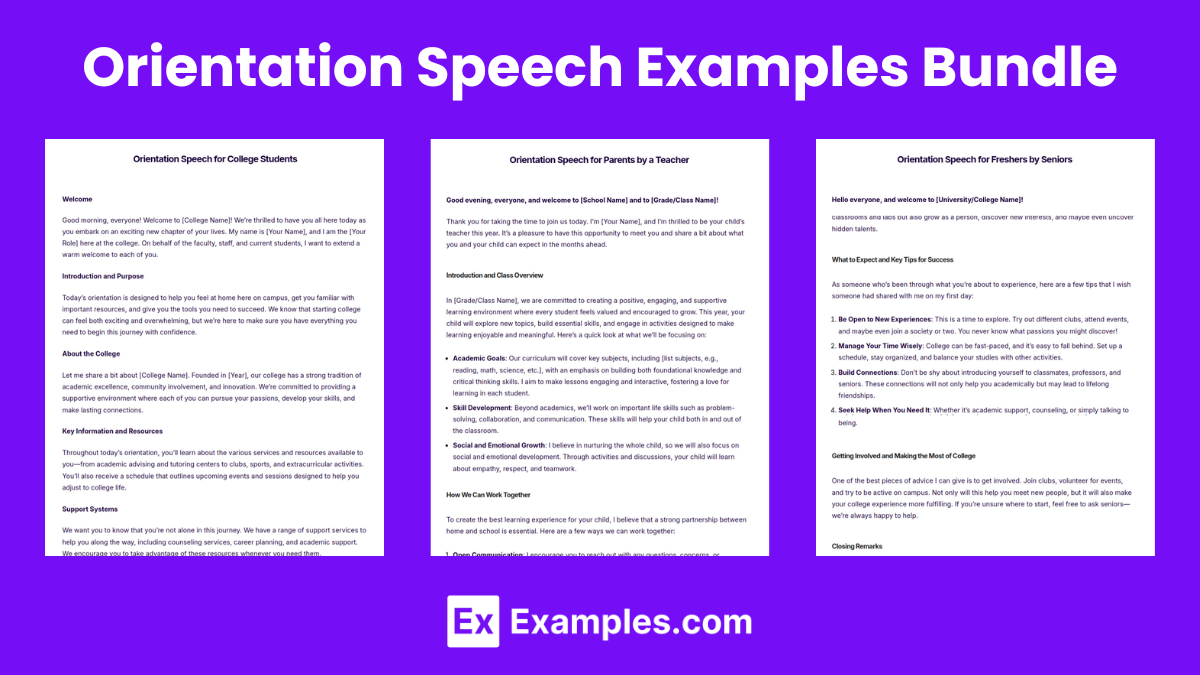
Download Orientation Speech Examples Bundle
Orientation speech Format
Introduction
- Greeting: Start with a warm welcome to your audience.
- Self-Introduction: Briefly introduce yourself and your role within the organization.
- Acknowledgment: Recognize key individuals, such as organizers, and express appreciation for the audience’s presence.
Purpose of the Orientation
- Explain the Objective: Clarify the purpose of the orientation and what you hope to achieve.
- Set the Tone: Establish a positive and welcoming atmosphere, emphasizing inclusivity and support.
Overview of the Organization or Program
- Background Information: Provide a brief history or background of the organization or program.
- Mission and Values: Highlight the core mission, values, and culture to give the audience a sense of belonging.
Key Information and Logistics
- Schedules and Agenda: Outline the key components of the event or program, such as schedules, timelines, and important dates.
- Roles and Responsibilities: Define any roles, expectations, or responsibilities the audience members might have.
Available Resources and Support Systems
- Resources: Inform about any resources, such as handbooks, guides, or contacts, that will aid their orientation process.
- Support Services: Highlight available support systems, such as advisors, mentors, or counselors, and explain how to access them.
Guidelines and Expectations
- Code of Conduct: Discuss any rules, guidelines, or policies that audience members need to follow.
- Expectations for Participation: Encourage active involvement and outline any expectations related to attendance, participation, or contributions.
Tips for Success and Engagement
- Suggestions: Offer advice on how to make the most of the experience, such as networking, joining activities, or utilizing resources.
- Encouragement: Provide words of encouragement to build confidence and enthusiasm.
Questions and Open Forum
- Invite Questions: Open the floor for any questions or concerns, allowing the audience to seek clarification.
- Provide Answers: Address questions thoughtfully and ensure that everyone feels heard and understood.
Closing Remarks
- Final Encouragement: Reiterate your support and express confidence in the audience’s ability to succeed.
- Thank the Audience: Express gratitude for their attention and engagement.
- Call to Action: End with a motivating call to action, such as inviting them to explore, participate, or reach out for support when needed.
Orientation Speech Example
Welcome to [Your Organization/Program]!
Good afternoon, everyone! I’m delighted to welcome you to our orientation today. My name is [Your Name], and I’m the [Your Position] here at [Organization/Program Name]. It’s a pleasure to see all of you here, ready to embark on this new journey.
Today’s Goals
This orientation is designed to help you feel comfortable and informed as you begin this new experience. We’ll go over essential information, introduce you to key resources, and give you an overview of what to expect in the coming days. We’re here to make sure you’re ready to succeed!
About Us
Let me tell you a bit about who we are. [Organization/Program Name] was founded with the mission of [Mission Statement]. Our core values are [Values, e.g., respect, innovation, community], and we’re excited to have you join us as we continue to grow together.
What You Need to Know
Today, we’ll cover the schedule and some important logistics, like where to find resources and how to reach out for help. Please refer to your agenda for details about today’s events and some key dates moving forward.
Support and Resources
Remember, we’re here to support you. We have advisors, mentors, and a wealth of resources to guide you. You’ll find everything you need to get started in your welcome packet, including contact information for our support team.
Expectations and Conduct
As part of our community, we ask that you follow a few simple guidelines that ensure a positive experience for everyone. Please respect others, take part in our activities, and make the most of the opportunities here.
Tips for Getting Involved
My advice? Jump right in! Join clubs, attend events, and make connections. The more you engage, the more you’ll gain from your time with us. Don’t hesitate to reach out, ask questions, and explore all we have to offer.
Questions?
Now, I’d like to open the floor to any questions. We want to make sure you have everything you need to get started on the right foot.
Closing Remarks
Once again, welcome to [Organization/Program Name]. We’re thrilled to have you with us and can’t wait to see all you’ll accomplish. Thank you for joining us today, and let’s make this an incredible experience together. Welcome aboard!
Orientation Speech for College Students
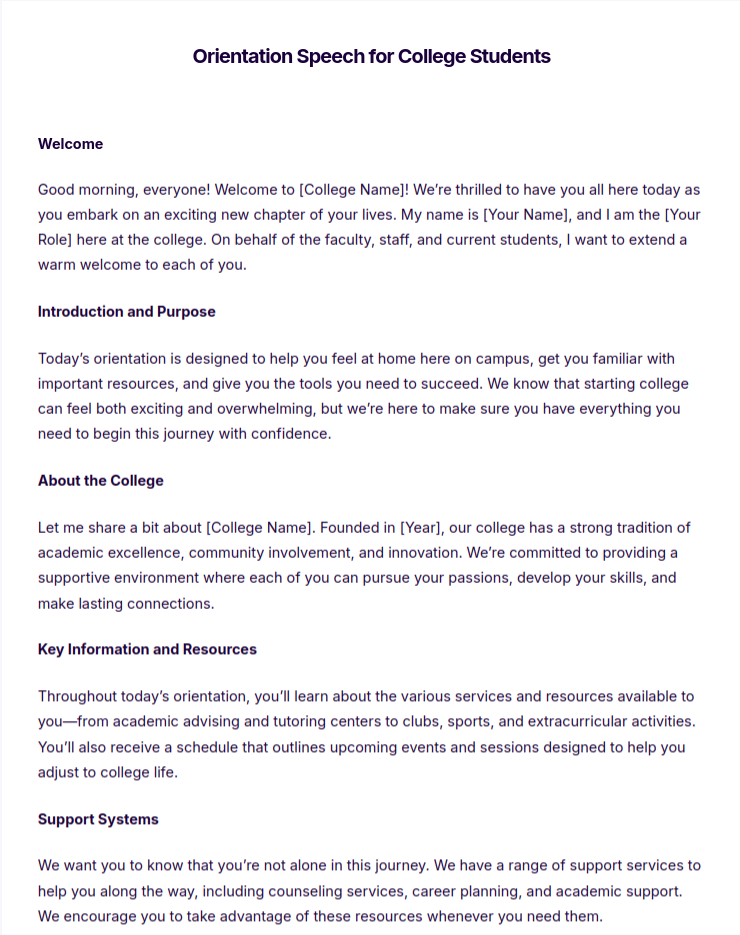
Orientation Speech for Freshers by Seniors
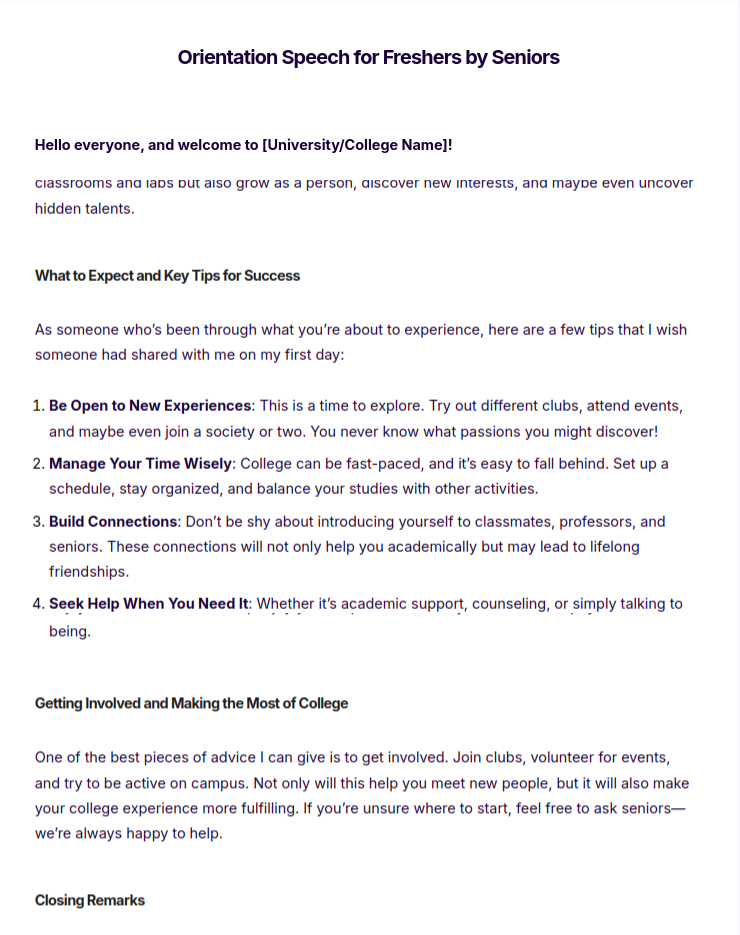
Orientation Speech for Parents by a Teacher
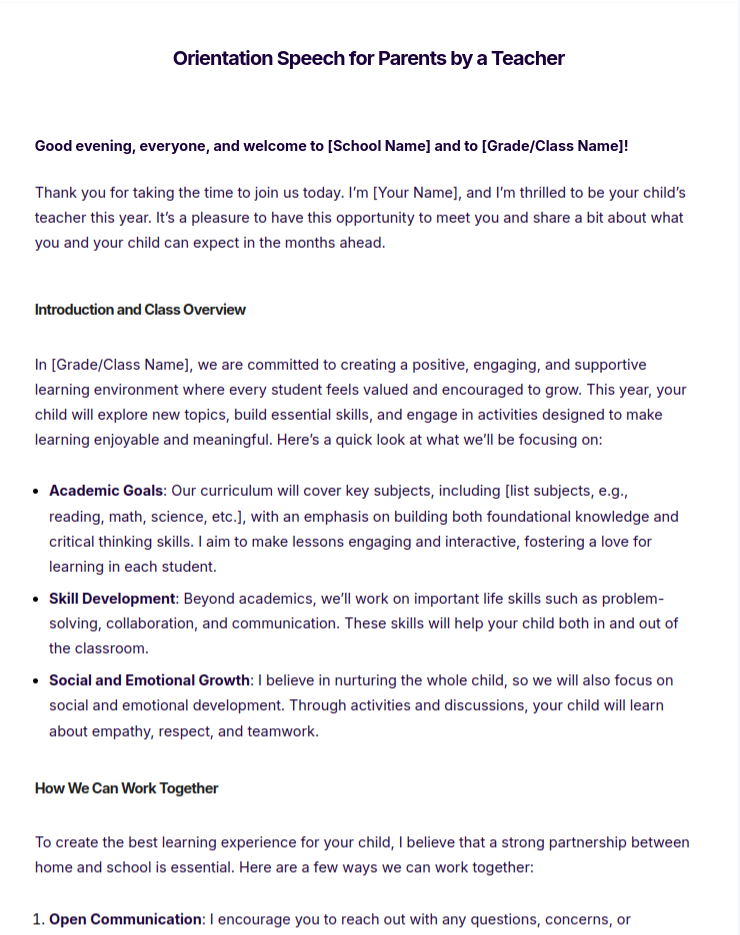
More Orientation Speech Examples and Samples
- Orientation Speech for Law Students
- Orientation Speech for Medical Students
- Orientation Speech for Engineering Students
- Orientation Speech for Parents by the Principal
Orientation Speech for Freshers
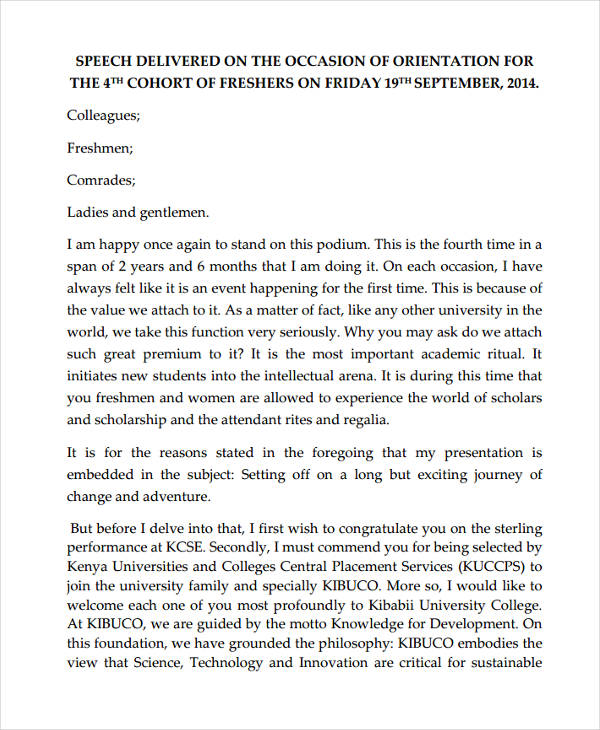
Speech for Parents
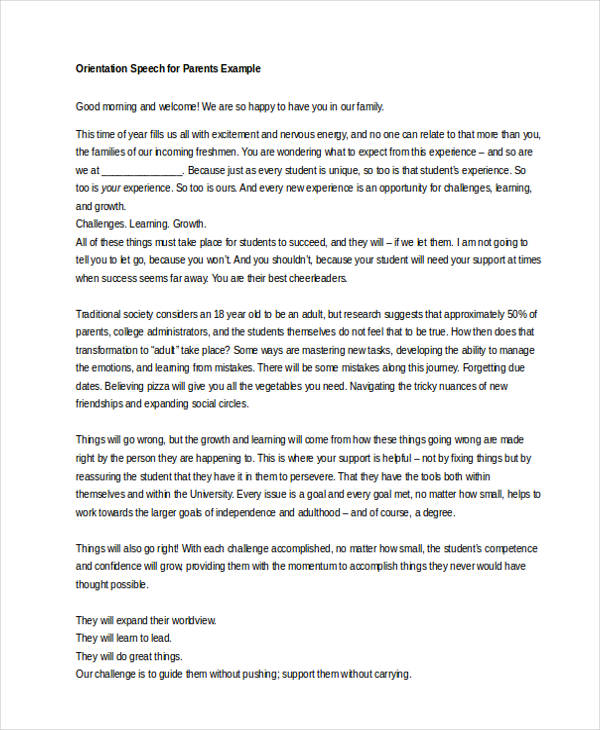
Principal Orientation Speech Sample
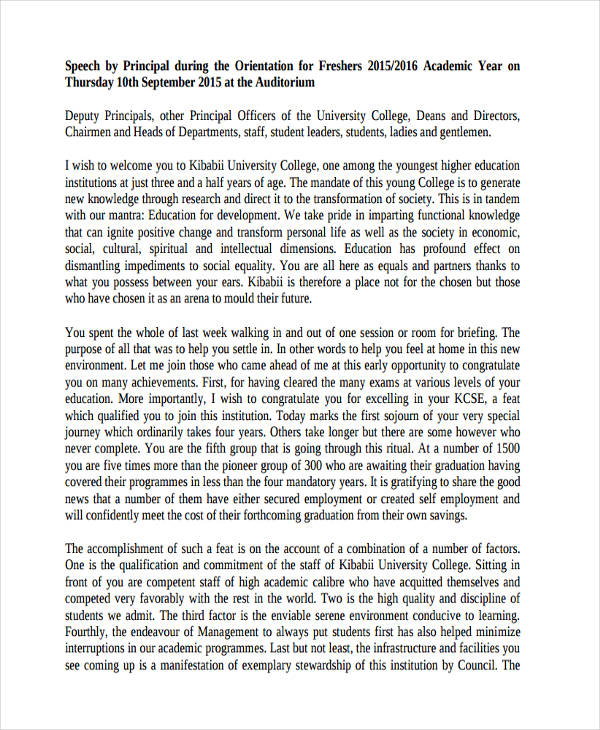
Speech for New Batch

Orientation Speech for New Students
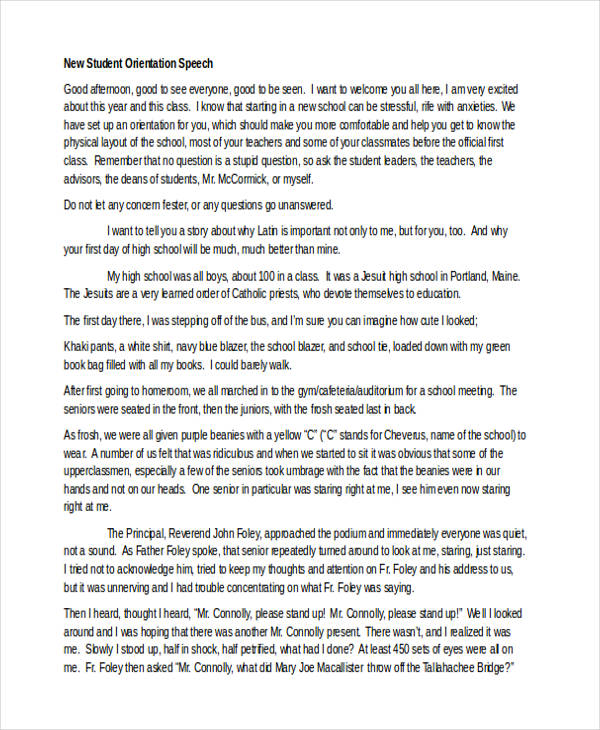
Speech for Teachers

Short Orientation Speech
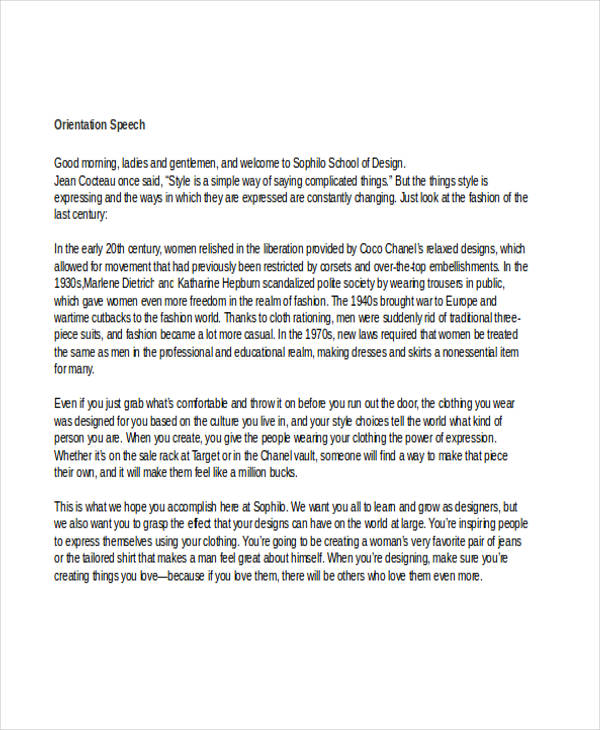
Purpose of an Orientation Speech
The main goal of an orientation speech is to provide guidance and create a welcoming atmosphere. It helps new participants feel comfortable and informed, which sets a positive tone for their experience. An orientation speech often includes:
- Introductions: Speakers, organizers, or leaders introduce themselves to build rapport with the audience.
- Overview of the Program: A summary of what the program, course, or event will cover, including objectives and benefits.
- Expectations and Guidelines: Key rules, procedures, and expectations are outlined to ensure participants know what’s required of them.
- Resources and Support: Information on available resources, such as academic support, counseling services, or work tools, to assist participants during their experience.
- Questions and Answers: A brief Q&A session to address any immediate concerns or questions from the audience.
How to Write an Orientation Speech?
Writing an orientation speech involves welcoming new participants and providing them with essential information to help them get started. Here’s a step-by-step guide to help you craft an effective orientation speech:
Know Your Audience
Before you start writing, consider who you’re addressing. Are they students, parents, employees, or volunteers? Understanding your audience will help you tailor your message, tone, and content to meet their specific needs and expectations.
Start with a Warm Welcome
Begin your speech with a friendly and inviting greeting. Express your excitement about welcoming them and acknowledge the significance of the event or program they’re joining.
Example:
“Good morning, everyone! Welcome to [School/Organization/Event Name]. We’re thrilled to have you here and excited to start this journey with you!”Introduce Yourself and Your Role
Briefly introduce yourself and explain your connection to the event or program. This helps establish credibility and builds rapport with the audience.
Example:
“My name is [Your Name], and I’m the [Your Position, e.g., Principal, Orientation Leader, HR Manager]. I’m here to help guide you through what to expect as you begin this new chapter.”Provide an Overview of the Program or Event
Summarize what the participants can expect from the program, course, or job. Mention key topics, goals, or objectives and what they will gain from this experience.
Example:
“Over the next few days/weeks, you’ll be learning about [mention core topics or areas, e.g., our company values, the academic curriculum, etc.]. Our goal is to equip you with the knowledge and skills needed to succeed here.”Outline Important Expectations and Responsibilities
Clearly state any expectations, rules, or responsibilities that participants should know. This might include behavioral guidelines, attendance policies, or other requirements. This sets a clear tone and helps avoid confusion later on.
Example:
“We ask that you commit to being punctual, engaged, and respectful throughout the program. Your active participation will make this experience more meaningful for everyone.”Highlight Available Resources and Support
Let your audience know about resources, support systems, and key contacts. Mention any mentors, advisors, or services available to help them succeed.
Example:
“Our faculty and support staff are here to assist you. We have resources such as [mention relevant resources, e.g., a counseling center, online portals, mentors], so please don’t hesitate to reach out.”Provide Practical Tips for Success
Share a few tips or pieces of advice to help participants get the most out of their experience. This could include suggestions on managing time, staying organized, or getting involved.
Close with Encouragement and Enthusiasm
Wrap up your speech with an encouraging message, expressing confidence in their ability to succeed. End on a positive note, leaving them motivated and excited.
Example:
“We are so excited to have you here and can’t wait to see all that you’ll accomplish. Welcome once again to [School/Organization/Event Name]—let’s make this a fantastic experience together!”
Tips on Preparing an Orientation Speech
The problems encountered by most keynote speech is that it is too boring and overwhelming. That is because of inadequate preparation and neglecting its importance. So, if you are given a task to deliver an orientation speech, be sure to follow these basic guidelines to prevent those unwanted circumstances.
- Prepare in advance. As always, it is very important that you prepare your speech and your materials ahead of time. So that when the time comes, you are now ready and you are in control of your speech.
- Know your audience. It is also very important to know who you are giving your orientation speech to as this will determine your entire speech.
- Create a speech outline. Speech outline will make everything easy for you. It will organize and group your main ideas and guide you logically in your speech.
- Make your orientation speech conversational. Do not talk the entire time. Allow your audience to connect and talk with you.
- Be humorous. Orientations are not that formal. You can make funny side notes to ensure that your audience will have a good time in your orientation speech.
You can also get more ideas on how to prepare a good speech with our self-introduction speech examples and other speech examples in PDF and Word format here.
FAQ’s
How long should an orientation speech be?
An orientation speech should typically be between 5 to 10 minutes. This allows enough time to cover key points without overwhelming the audience with too much information. However, the length can vary depending on the context and audience needs.
How can I make my orientation speech engaging?
Use a friendly and welcoming tone, personalize your message, and include anecdotes or examples if possible. Maintain eye contact with the audience and use gestures to emphasize key points. Additionally, encourage audience participation, such as inviting questions or sharing personal experiences.
How formal should my speech be?
The formality of your speech depends on the setting and audience. For academic or professional settings, a formal tone is appropriate, but it should still be warm and inviting. For more casual orientations, such as those for student clubs or social groups, a relaxed and conversational tone may be more suitable.
How can I prepare for delivering the speech?
Start by writing an outline and then flesh out your key points. Practice delivering the speech several times to ensure smooth delivery. If possible, practice in front of a friend or colleague for feedback. Familiarize yourself with the setting and consider using visual aids if they can enhance your presentation.
What should I do if I get nervous while giving the speech?
Take deep breaths and try to focus on the positive aspects of the experience. Remember that the audience is there to listen and learn, not to judge. If you lose your place, pause briefly, refer back to your notes if needed, and continue. Practicing beforehand can help reduce nerves on the day.


